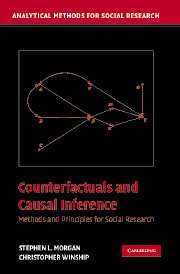Book contents
- Frontmatter
- Contents
- Acknowledgments
- Part 1 Counterfactual Causality and Empirical Research in the Social Sciences
- Part 2 Estimating Causal Effects by Conditioning
- 3 Causal Graphs, Identification, and Models of Causal Exposure
- 4 Matching Estimators of Causal Effects
- 5 Regression Estimators of Causal Effects
- Part 3 Estimating Causal Effects When Simple Conditioning Is Ineffective
- Part 4 Conclusions
- References
- Index
4 - Matching Estimators of Causal Effects
Published online by Cambridge University Press: 05 June 2012
- Frontmatter
- Contents
- Acknowledgments
- Part 1 Counterfactual Causality and Empirical Research in the Social Sciences
- Part 2 Estimating Causal Effects by Conditioning
- 3 Causal Graphs, Identification, and Models of Causal Exposure
- 4 Matching Estimators of Causal Effects
- 5 Regression Estimators of Causal Effects
- Part 3 Estimating Causal Effects When Simple Conditioning Is Ineffective
- Part 4 Conclusions
- References
- Index
Summary
The rise of the counterfactual model to prominence has increased the popularity of data analysis routines that are most clearly useful for estimating the effects of causes. The matching estimators that we will review and explain in this chapter are perhaps the best example of a classic technique that has reemerged in the past two decades as a promising procedure for estimating causal effects. Matching represents an intuitive method for addressing causal questions, primarily because it pushes the analyst to confront the process of causal exposure as well as the limitations of available data. Accordingly, among social scientists who adopt a counterfactual perspective, matching methods are fast becoming an indispensable technique for prosecuting causal questions, even though they usually prove to be the beginning rather than the end of causal analysis on any particular topic.
We begin with a brief discussion of the past use of matching methods. Then, we present the fundamental concepts underlying matching, including stratification of the data, weighting to achieve balance, and propensity scores. Thereafter, we discuss how matching is usually undertaken in practice, including an overview of various matching algorithms. Finally, we discuss how the assumptions behind matching estimators often break down in practice, and we introduce some of the remedies that have been proposed to address the resulting problems.
- Type
- Chapter
- Information
- Counterfactuals and Causal InferenceMethods and Principles for Social Research, pp. 87 - 122Publisher: Cambridge University PressPrint publication year: 2007
- 1
- Cited by

